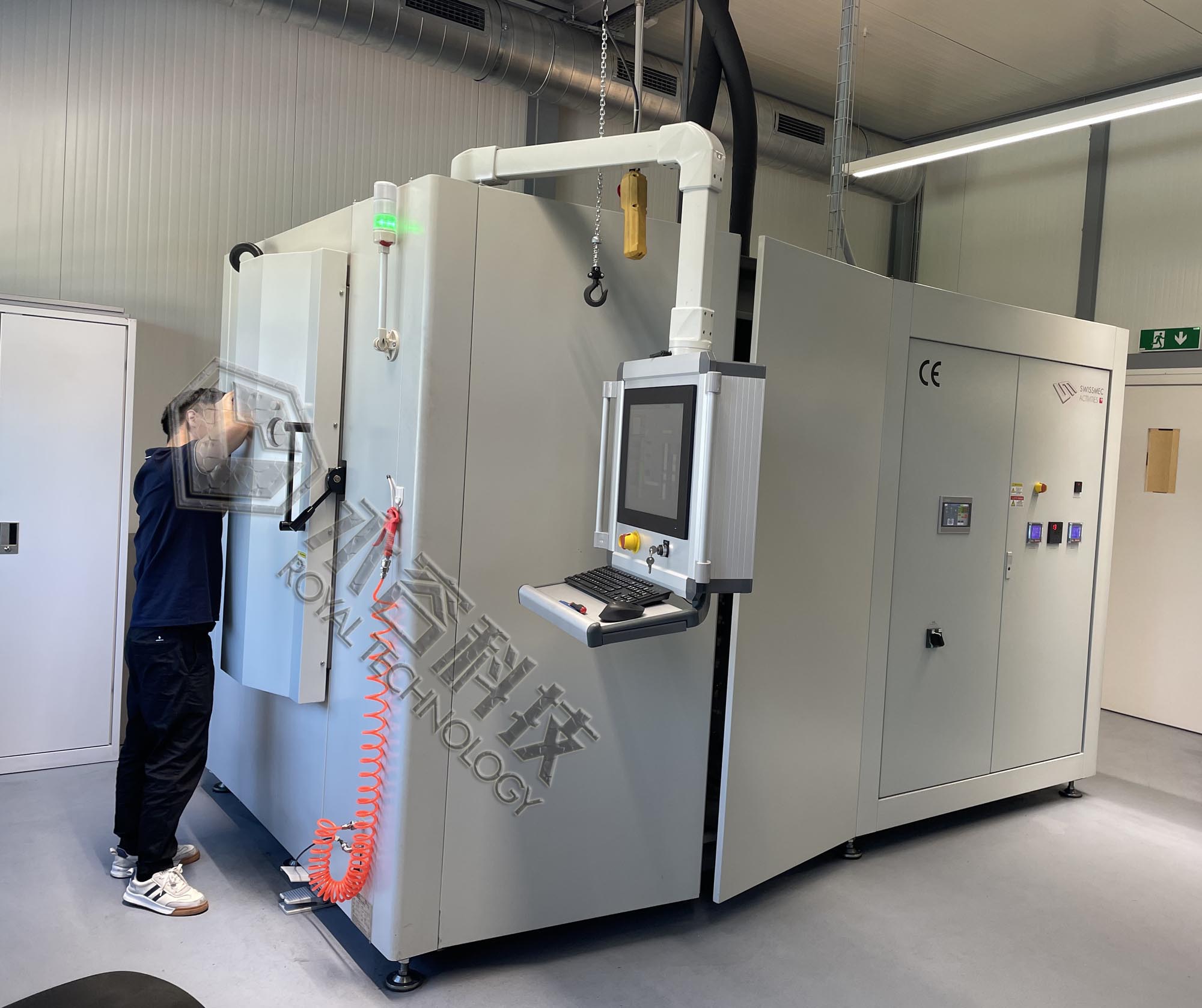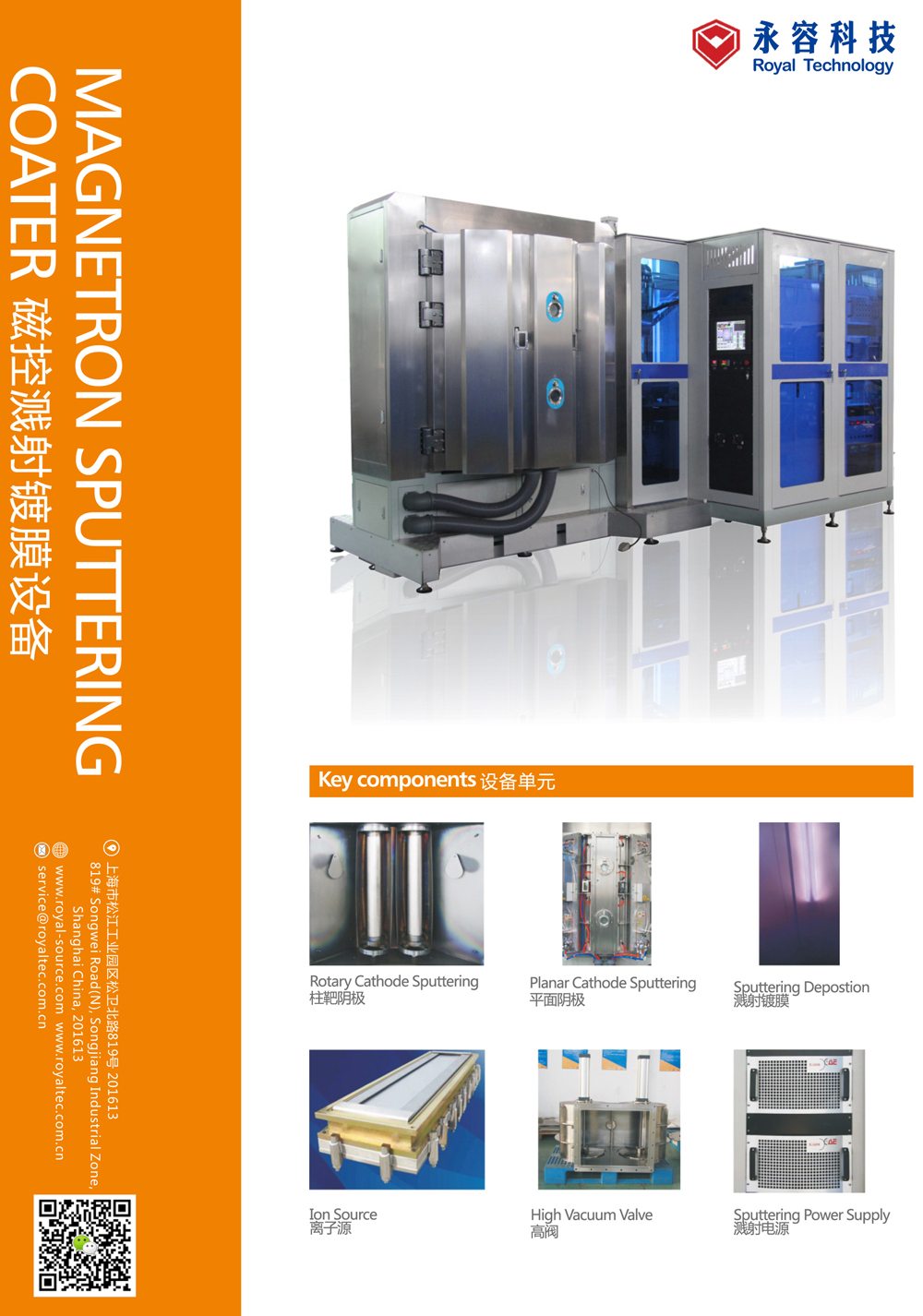Unbalanced Magnetron Sputtering Deposition (UMSD) is a technique used in physical vapor deposition (PVD) processes to deposit thin films onto substrates. In an Unbalanced Magnetron Sputtering Deposition machine, the sputtering process is enhanced using an unbalanced magnetic field to improve film quality and deposition rates.
Royal Technology has designed and produced the UMSD machine for the industrial applications.
Principle:
Unbalanced Magnetron Sputtering involves using an unbalanced magnetic field to enhance the sputtering process. This unbalanced field increases the electron mean free path and ionization efficiency, leading to improved film quality and deposition rates.
Advantages:
Higher deposition rates: The unbalanced magnetic field accelerates the electrons, leading to increased ionization and higher deposition rates.
Improved film quality: The enhanced ionization efficiency results in films with better adhesion, density, and uniformity.
Better control: The unbalanced magnetic field allows for better control over the deposition process, enabling the deposition of complex multilayer structures.
Machine Components:
Cathode (Target): The material to be deposited is placed as a cathode target inside the vacuum chamber.
Anode: A positively charged electrode that attracts the electrons from the cathode.
Magnetron: A magnetron is used to create the magnetic field that enhances the sputtering process.
Substrate Holder: The substrate where the thin film is deposited is placed on a holder inside the chamber.
Challenges:
Uniformity: Achieving uniform film thickness across large substrates can be a challenge.
Process Control: Fine-tuning the process parameters to achieve the desired film properties can be complex.
In summary, an Unbalanced Magnetron Sputtering Deposition machine is a specialized PVD system that utilizes an unbalanced magnetic field to enhance the sputtering process, leading to improved film quality and deposition rates in various industrial applications.
Applications:
Unbalanced Magnetron Sputtering is commonly used in the semiconductor industry, optical coatings, flat panel displays, and other industries requiring precision thin film deposition like Plastic, Polymer, Glass and ceramic sheets, Stainless steel, Copper sheet, Aluminum board etc.
The Mangetron Sputtering Deposition machine is designed for copper, aluminum, plastic, metal circuit board conductive film layer plating. It can condense Nano thin film on substrates. Except Ag sputtering, it can also deposit TiN, TiC, TiCN, Cr, CrC, CrN, Cu, Au, Ni, Al, ITO, Nb, Ta etc.
Semiconductor Industry: Used for coating semiconductor wafers with thin films for electronic devices.
Optics: Depositing anti-reflective coatings, mirrors, and optical filters.
Solar Cells: Coating photovoltaic cells with thin films to enhance efficiency.
Tool and Wear Protection: Coating cutting tools and components with wear-resistant films.
Design Features:
Robust design, good for limited room space
Easy access for maintenance and repair
Fast pumping system for high yield
CE standard electrical enclosure, UL standard is also available.
Accurate fabrication workmanship
Stable running to guarantee high quality film production.
The key feature is that Royal's customized operation and control program and software, which is available to meet various requests from customer's demands. The control system isSiemens PLC + Industrial Computer (IPC)
Coating Advantages
Uniform Coating: Magnetron sputtering provides a highly uniform coating over large areas, making it suitable for industrial-scale production.
Controlled Deposition: The process allows precise control over the thickness, composition, and microstructure of the deposited film.
Wide Material Compatibility: Magnetron sputtering can deposit a variety of materials, including metals, oxides, nitrides, and more.
Unbalanced and closed field magnetron processes have all the advantages of planar magnetrons.
Additional advantages and disadvantages are:
Additional ion bombardment resulting in dense, adherent films
Ion assist and substrate cleaning possible
Improved tribological, wear and corrosion resistant films· Amenable to multilayer, superlattice, nanolaminant and nanocomposite films
Poorer materials usage
More complex cathode configuration/expense
Unbalanced and closed field magnetron sputtering revolutionized properties achievable by magnetron sputtering processes. As successful with improved thin film tribological, corrosion resistance and optical properties as this technology was, improvements in magnetron technology had just begun.
Above Artical from PETER MARTIN
The machine is installed with 2 pairs of MF sputtering cathodes on chamber, before PVD film deposition and 1 set of Anode Layer Ion source for plasma bombardment cleaning.
Ion source is original from Gencoa company, the properties:
Optimized magnetic fields to produce a the plasma beam at standard sputtering pressures
Automated regulation for the gas to maintain constant current & voltage – multi-gas auto control
Graphite anode and cathode to protect the substrate from contamination and provide long-life components
RF standard electrical insulation on all ion sources
In-direct cooling of anode and cathode – quick switching of parts
Easy switching of cathode parts to provide multiple magnetic traps for lower voltage operation, or a focused beam
Voltage regulated power supply with gas adjustment feedback to maintain same current at all times
|
MODEL |
RTSP1250 |
|
MATERIAL |
Stainless Steel (S304) |
|
CHAMBER SIZE |
Φ1250*1250mm (H) |
|
CHAMBER TYPE |
1-door structure, Vertical |
|
SINGLE PUMP PACKAGE |
Rotary VaneVacuum Pump |
|
Roots Vacuum Pump |
|
|
Magnetic Suspension Molecular Pump |
|
|
Two-stage rotary vane vacuum pump |
|
|
TECHNOLOGY |
MF Magnetron Sputtering, Linear Ion Source |
|
POWER SUPPLY |
Sputtering power supply + Bias Power supply + Ion Source |
|
DEPOSITION SOURCE |
2 pairs MF Sputtering Cathodes + Ion Source |
|
CONTROL |
PLC+Touch Screen |
|
GAS |
Gas Mass Flow Meters ( Ar, N2, C2H2, O2) Argon, Nitrogen and Ethyne,Oxygen |
|
SAFETY SYSTEM |
Numerous safety interlocks to protect operators and equipment |
|
COOLING |
Cooling Water |
|
CLEANING |
Glow Discharge/Ion Source |
|
POWER MAX. |
120KW |
|
AVERAGE POWER CONSUMPTION |
70KW |



